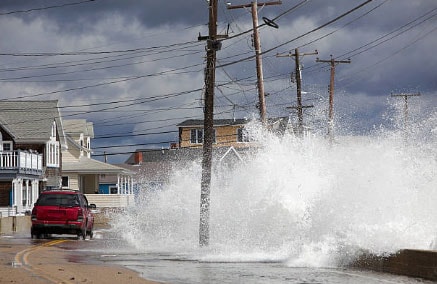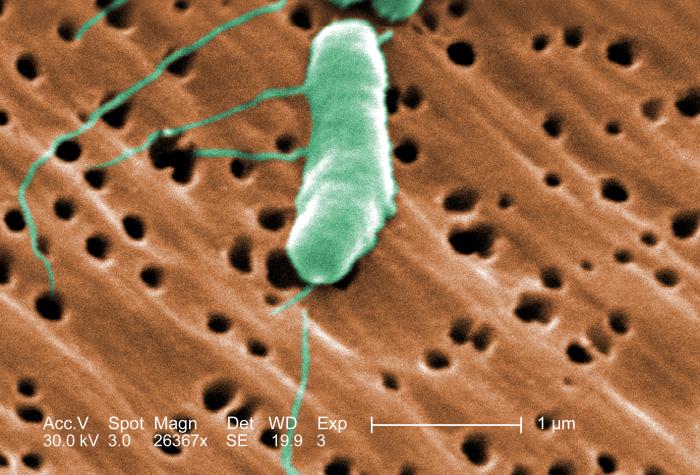Archive for the ‘Vibrio vulnificus’ Category
CDC: Vibrio vulnificus Infections and Disasters
Thursday, June 20th, 2019
CDC/ Janice Haney Carr: Under a high magnification of 26367X, this digitally-colorized scanning electron microscopic (SEM) image depicted a flagellated Vibrio vulnificus bacterium.
What is Vibrio vulnificus?
Vibrio vulnificus is one of about a dozen species of Vibrio bacteria that can cause human illness, called vibriosis. Vibrio naturally live in certain coastal waters and are present in higher concentrations between May and October when water temperatures are warmer. Those months overlap with the time when hurricanes and tropical storms are more likely to affect the U.S. mainland and many U.S. territories.
Who is more likely to get a Vibrio vulnificus infection?
Anyone can get a Vibrio vulnificus infection. People with a compromised immune system or liver disease are more likely to get an infection and severe complications. Learn about other medical conditions that increase your chance of infection.
How do people get a Vibrio vulnificus infection?
In the United States, people most often become infected with Vibrio vulnificus and other species of Vibrio by eating raw or undercooked shellfish, particularly oysters. Certain Vibrio species, including Vibrio vulnificus, can also cause a skin infection when an open wound is exposed to brackish or salt water. Brackish water is a mixture of fresh and sea water that is often found where rivers meet the sea.
When a hurricane or storm surge causes flooding, you may be exposed to coastal water. If you are in a group more likely to get a Vibrio vulnificus infection, it is especially important to take steps to reduce your risk of infection.
Learn how to reduce your risk of Vibrioinfection from raw or undercooked oysters or other shellfish or contact with their juices.
How can I protect myself from a Vibrio vulnificus infection during hurricanes and other natural disasters?
You can reduce your risk of infection by following these tips regarding wounds:
- Stay out of brackish or salt water if possible if you have a wound. Cover your wound with a waterproof bandage if there’s a possibility it could come into contact with brackish or salt water, raw seafood, or raw seafood juices.
- Wash wounds and cuts thoroughly with soap and water if they have been exposed to brackish or salt water, or raw seafood or its juices.
- If you develop a skin infection, tell your medical provider if your skin has come into contact with brackish or salt water, raw seafood, or raw seafood juices.
V. vulnificus infection should be considered for infected wounds that were exposed to coastal waters. Treatment should be initiated immediately because antibiotics improve survival. Aggressive attention should be given to the wound site; amputation of the infected limb is sometimes necessary.
- Culture of wound or hemorrhagic bullae is recommended, and all V. vulnificus isolates should be forwarded to a public health laboratory
- Blood cultures are recommended if the patient is febrile, has hemorrhagic bullae, or has any sign of sepsis
- Necrotic tissue should be debrided; severe cases may require fasciotomy or limb amputation
- Antibiotic therapy: Doxycycline (100mg PO/IV twice a day for 7–14 days) and a third-generation cephalosporin (e.g., ceftazidime 1–2g IV/IM every eight hours) is generally recommended
- A single agent regimen with a fluoroquinolone such as levofloxacin, ciprofloxacin, or gatifloxacin, has been reported to be at least as effective in an animal model as a regimens with doxycycline and a cephalosporin
- Children, in whom doxycycline and fluoroquinolones are sometimes contradicted, can be treated with trimethoprim-sulfamethoxazole plus an aminoglycoside
Climate change: Vibrio vulnificus reaches Delaware Bay
Wednesday, June 19th, 2019“…..In the past two years, five cases of Vibrio vulnificus, a flesh-eating bacterial infection that is spread by handling or eating contaminated seafood, have been linked to Delaware Bay……
Vibrio vulnificus usually occurs in high-salinity, brackish waters with surface temperatures above 13 degrees Celsius, or 55 degrees Fahrenheit, the study says. It has typically been found in the warm waters of the Gulf Coast and southern states like Louisiana and Texas, especially during the months from May to October.
Vibrio vulnificus causes about 205 infections in the United States every year the CDC estimates. The CDC also said it is important to learn more about the harmful bacteria if you live in areas where hurricanes, storm surges and coastal flooding are possible. The most common cause of infection is eating raw or undercooked shellfish, particularly oysters…..”
King M, Rose L, Fraimow H, Nagori M, Danish M, Doktor K. Vibrio vulnificus Infections From a Previously Nonendemic Area. Ann Intern Med. [Epub ahead of print 18 June 2019] doi: 10.7326/L19-0133



